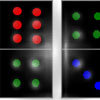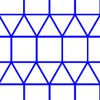Skip over navigation
Article by Alison Kiddle and Liz Woodham
There is a wide body of research, particularly in primary mathematics education, showing the benefits of using manipulatives to help children to develop new concepts and understanding. In the article Manipulatives in the Primary Classroom, Jenni Back explores this research landscape.
But where do digital manipulatives fit into the picture? Ruthven (1989) proposed a model of teaching mathematics in which an exploration phase took place first, and then the teacher provided codification, drawing together the ideas discovered by students in the exploratory phase, before moving on to consolidation work. This was in contrast to the more traditional teaching model consisting of exposition by the teacher followed by consolidation. Much research since then has highlighted the benefits of being playful and having the chance to explore when being exposed to new mathematical ideas for the first time. Our Autumn 2018 Primary and Secondary features on NRICH bring together resources that provide digital environments and interactivities where learners can explore and be playful in order to make discoveries. The younger generation of so-called Digital Natives feel at home using laptops, tablets or phones to interact with digital environments, and we have chosen mathematical ideas which will allow them to indulge their curiosity.
 Research into digital manipulatives includes a healthy scepticism about whether an interactive environment has the same benefits as a physical one. We suggest that it doesn't need to be an either/or situation, and that providing both physical manipulatives and digital alternatives in the classroom
can offer students motivation, insight and opportunities that using just one would not. Take for example the task 4 Dom. Some learners might find that the interactivity encourages more careful planning of where to place a domino, simply because the act of moving it is more conscious compared with sliding/turning a real domino. However, other students may prefer the freer
movement of real dominoes, enabling them to arrange them in a square without worrying about the totals intially and then progressing using a trial and improvement approach.
Research into digital manipulatives includes a healthy scepticism about whether an interactive environment has the same benefits as a physical one. We suggest that it doesn't need to be an either/or situation, and that providing both physical manipulatives and digital alternatives in the classroom
can offer students motivation, insight and opportunities that using just one would not. Take for example the task 4 Dom. Some learners might find that the interactivity encourages more careful planning of where to place a domino, simply because the act of moving it is more conscious compared with sliding/turning a real domino. However, other students may prefer the freer
movement of real dominoes, enabling them to arrange them in a square without worrying about the totals intially and then progressing using a trial and improvement approach.
 Another task features the Tessellation interactive environment. Students can explore tessellations by drawing round shapes or fitting pattern blocks together. However, when starting to get into explorations of classifying all the semi-regular
tessellations and finding how the angle properties of regular polygons limit the possibilities, the inaccuracies of drawing round or cutting out shapes and the time-consuming nature of creating the patterns might hold some students back. By switching from physical to digital and using the environment, students can very quickly test out conjectures and build up accurate patterns that they can
screenshot and put into presentations. In this way, they have the opportunity to make discoveries that the physical world alone might not have allowed.
Another task features the Tessellation interactive environment. Students can explore tessellations by drawing round shapes or fitting pattern blocks together. However, when starting to get into explorations of classifying all the semi-regular
tessellations and finding how the angle properties of regular polygons limit the possibilities, the inaccuracies of drawing round or cutting out shapes and the time-consuming nature of creating the patterns might hold some students back. By switching from physical to digital and using the environment, students can very quickly test out conjectures and build up accurate patterns that they can
screenshot and put into presentations. In this way, they have the opportunity to make discoveries that the physical world alone might not have allowed.
Any article about digital manipulatives must include a note on dynamic geometry. Problems such as Quad in Quad could be started using paper and pencil, with students drawing a few examples and making conjectures, but the power of an interactive diagram makes it simple to perceive generality, and see what stays the same and what changes, in a way that a limited set of drawings cannot. Some teachers worry that students will take the computer's word for it and miss out on the crucial step of proving conjectures, so it is important that when using dynamic geometry such as GeoGebra, teachers discuss proof and how the computer can help us to see what needs to be proved and come up with ideas for how to prove it, but ultimately it is up to us to provide a convincing argument.
We hope that you and your students will enjoy exploring the tasks in the Primary and Secondary features and we are looking forward to receiving students' solutions and seeing where their curiosity takes them. We would also love to hear from teachers about how you have used these digital manipulatives in your classroom; you can contact the NRICH Primary and Secondary teams via email, or get in touch with us via Twitter.
References:
Ruthven K (1989) An Exploratory Approach to Advanced Mathematics. Educational Studies in Mathematics 20: 449-467
Or search by topic
Number and algebra
Geometry and measure
Probability and statistics
Working mathematically
Advanced mathematics
For younger learners
Age 5 to 16
Published 2018
Using Digital Manipulatives and Interactivities to Develop Curiosity
There is a wide body of research, particularly in primary mathematics education, showing the benefits of using manipulatives to help children to develop new concepts and understanding. In the article Manipulatives in the Primary Classroom, Jenni Back explores this research landscape.
But where do digital manipulatives fit into the picture? Ruthven (1989) proposed a model of teaching mathematics in which an exploration phase took place first, and then the teacher provided codification, drawing together the ideas discovered by students in the exploratory phase, before moving on to consolidation work. This was in contrast to the more traditional teaching model consisting of exposition by the teacher followed by consolidation. Much research since then has highlighted the benefits of being playful and having the chance to explore when being exposed to new mathematical ideas for the first time. Our Autumn 2018 Primary and Secondary features on NRICH bring together resources that provide digital environments and interactivities where learners can explore and be playful in order to make discoveries. The younger generation of so-called Digital Natives feel at home using laptops, tablets or phones to interact with digital environments, and we have chosen mathematical ideas which will allow them to indulge their curiosity.
Any article about digital manipulatives must include a note on dynamic geometry. Problems such as Quad in Quad could be started using paper and pencil, with students drawing a few examples and making conjectures, but the power of an interactive diagram makes it simple to perceive generality, and see what stays the same and what changes, in a way that a limited set of drawings cannot. Some teachers worry that students will take the computer's word for it and miss out on the crucial step of proving conjectures, so it is important that when using dynamic geometry such as GeoGebra, teachers discuss proof and how the computer can help us to see what needs to be proved and come up with ideas for how to prove it, but ultimately it is up to us to provide a convincing argument.
We hope that you and your students will enjoy exploring the tasks in the Primary and Secondary features and we are looking forward to receiving students' solutions and seeing where their curiosity takes them. We would also love to hear from teachers about how you have used these digital manipulatives in your classroom; you can contact the NRICH Primary and Secondary teams via email, or get in touch with us via Twitter.
References:
Ruthven K (1989) An Exploratory Approach to Advanced Mathematics. Educational Studies in Mathematics 20: 449-467

